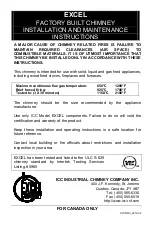
MAINTENANCE
PAGE 17
DOOR GASKET
A spun fiberglass gasket (3/4" [19 mm] in diameter) pro-
vides the seal around the fuel door. Should this become
frayed or damaged it should be replaced. Spun fiberglass
"rope" gasketing can be purchased from your dealer. It
must be the same diameter as the original. Use high
temperature silicone sealer as an adhesive, which can
also be purchased from your dealer.
WARNING! THE GASKETS MUST BE KEPT IN GOOD
CONDITION. DO NOT LEAVE THE STOVE BURNING
WITH THE DOOR OPEN OR AJAR (OTHER THAN
START UP AND REFUELING AS DEFINED IN THIS
MANUAL). THIS WILL CAUSE EXCESSIVE HEAT
BUILD UP IN THE APPLIANCE AND COULD IGNITE
SURROUNDING COMBUSTIBLES AS WELL AS DAM-
AGE THE STOVE BY OVERFIRING IT. OVERFIRING
IS A CONDITION WHERE EXCESSIVE TEMPERA-
TURES ARE REACHED, BEYOND THE DESIGN CA-
PABILITIES OF THE STOVE (SUCH DAMAGE IS NOT
COVERED BY THE MANUFACTURER'S WARRANTY).
SERVICING GLASS
CAUTION:
BE CAREFUL NOT TO ABUSE DOOR AS-
SEMBLY BY STRIKING OR SLAMMING IT. IF THE
DOOR ASSEMBLY OR GLASS IS BROKEN OR DAM-
AGED, THEY MUST BE REPLACED BEFORE
HEATER CAN BE SAFELY OPERATED. USE ONLY
COMPONENTS PROVIDED BY THE MANUFAC-
TURER AS REPLACEMENT PARTS.
Cleaning Glass:
Ensure stove is cold prior to cleaning
glass. A commercial glass cleaner designed for stoves is
recommended. Do not use abrasive cleaners.
Replacing Glass:
1. Remove door from stove by lifting door up and off
hinge pins: Place the door on a flat protected (towel)
clean flat surface with the inside of the door facing up.
Remove the glass clips (by removing screws holding
clips), then carefully remove broken glass one piece
at a time (protective gloves are recommended).
2. Clean area where the glass with gasket will be in-
stalled.
3. Install new glass with gasket (use only factory 5-mm
glass with glass channel gasket. Do not substitute).
Carefully reinstall glass clips. Be very careful not to
overtighten screws.
4. Reinstall door.
CLEANING BLOWERS
The blowers require inspection and cleaning annually to
remove lint, dust, etc. If there are pets in the dwelling, the
blowers should be cleaned at least twice a year To ac-
cess, remove blower covers (remove the two ¼” [7 mm]
hex head screws on each panel), then inspect propellers
(replace if cracked, broken or melted) and vacuum out
lint, dust, and debris.
CREOSOTE FORMATION AND NEED FOR REMOVAL
What is Creosote -
When wood is burned slowly, it pro-
duces tar and other organic vapors, which combine with
expelled moisture to form creosote. The creosote vapors
condense in the relatively cool chimney flue of a slow-
burning fire. As a result, creosote residue accumulates
on the flue lining. When ignited this creosote makes an
extremely hot fire. Also, creosote deposits tend to form in
long runs of venting where gases become too cool prior
to exhausting. Note: Single wall pipe cools rapidly, there-
fore installations using this type of flue are more suscep-
tible to creosote deposits.
To inhibit the build up of creosote, adjust the primary air
control to a medium-high or high setting for a 10-minute
period each day. Do not attempt to burn out heavy creo-
sote accumulations in this manner. This must be re-
moved from the chimney by scraping or brushing to re-
duce the risk of a chimney fire.
Burn Approved Fuel Only
- This stove is approved for
burning dry seasoned natural wood only. Using green or
inadequately seasoned wood may increase creosote
buildup.
Removal of Fireplace Insert for Inspection:
Pull Fireplace insert forward until the screws securing the
flue connection can be accessed. Detach flue by remov-
ing screws. Pull unit forward and out of fireplace. Inspect
the chimney and chimney connector as follows:
Inspection Frequency -
The chimney connector and
chimney should be inspected at least twice monthly dur-
ing the heating season to determine if a creosote buildup
has occurred. If creosote has accumulated it should be
removed to reduce the risk of a chimney fire.
To reinstall insert follow instructions on pages 9 and 10
(instructions # 8 through 12).
Summary of Contents for EARTH STOVE 2800HT
Page 26: ...SAFETY LISTING LABEL PAGE 26...
Page 27: ...EPA LABEL PAGE 27...













































